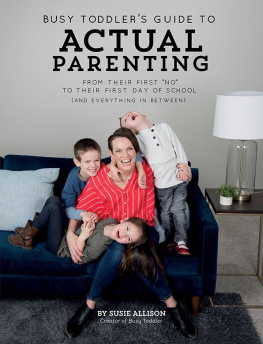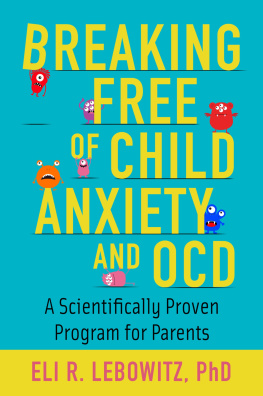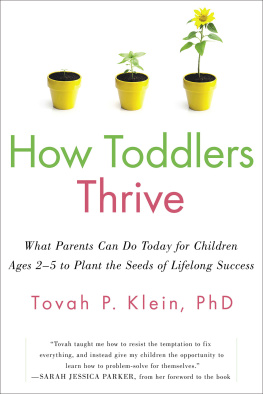
How to Parent Your Anxious Toddler
of related interest
The Panicosaurus
Managing Anxiety in Children Including Those with Asperger Syndrome
K.I. Al-Ghani
Ilustrated by Haitham Al-Ghani
ISBN 978 1 84905 356 3
eISBN 978 0 85700 706 3
Can I tell you about Anxiety?
A guide for friends, family and professionals
Lucy Willetts and Polly Waite
Part of the Can I tell you about? series
ISBN 978 1 84905 527 7
eISBN 978 0 85700 967 8
Constipation, Withholding and Your Child
A Family Guide to Soiling and Wetting
Anthony Cohn
ISBN 978 1 84310 491 9
eISBN 978 1 84642 562 2
Ready, Set, Potty!
Toilet Training for Children with Autism and Other Developmental Disorders
Brenda Batts
ISBN 978 1 84905 833 9
eISBN 978 0 85700 310 2
Liam Goes Poo in the Toilet
A Story about Trouble with Toilet Training
Jane Whelen Banks
ISBN 978 1 84310 900 6
eISBN 978 1 84642 874 6
Attacking Anxiety
A Step-by-Step Guide to an Engaging Approach to Treating Anxiety and Phobias in Children with Autism and Other Developmental Disabilities
Karen Levine and Naomi Chedd
ISBN 978 1 84905 788 2
eISBN 978 1 78450 044 3
How to Parent Your Anxious Toddler
Natasha Daniels

Jessica Kingsley Publishers
London and Philadelphia
First published in 2016
by Jessica Kingsley Publishers
73 Collier Street
London N1 9BE, UK
and
400 Market Street, Suite 400
Philadelphia, PA 19106, USA
www.jkp.com
Copyright Natasha Daniels 2016
Front cover image source: Shutterstock. The cover image is for illustrative purposes only, and any person featuring is a model.
All rights reserved. No part of this publication may be reproduced in any material form (including photocopying or storing it in any medium by electronic means and whether or not transiently or incidentally to some other use of this publication) without the written permission of the copyright owner except in accordance with the provisions of the Copyright, Designs and Patents Act 1988 or under the terms of a licence issued by the Copyright Licensing Agency Ltd, Saffron House, 610 Kirby Street, London EC1N 8TS. Applications for the copyright owners written permission to reproduce any part of this publication should be addressed to the publisher.
Warning: The doing of an unauthorized act in relation to a copyright work may result in both a civil claim for damages and criminal prosecution.
Library of Congress Cataloging in Publication Data
Daniels, Natasha.
How to parent your anxious toddler / Natasha Daniels.
pages cm
ISBN 978-1-84905-738-7 (alk. paper)
1. Anxiety in children. 2. Toddlers--Development. 3. Parenting. 4. Parent and child. I. Title.
BF723.A5D36 2016
649.123--dc23
2015016720
British Library Cataloguing in Publication Data
A CIP catalogue record for this book is available from the British Library
ISBN 978 1 84905 738 7
eISBN 978 1 78450 148 8
To my three children, who continually teach me more about life than anyone else and to my husband, who makes my life sparkle.
Contents
Introduction: What
Does an Anxious
Toddler Look Like?
Does your toddler get upset when his routine is disrupted? Does he follow you from room to room and is he unable to play on his own? Do you struggle with daily routines like mealtimes, bath time and bedtime? Sounds like most toddlers, right? Common toddler struggles are amplified for the anxious toddler. Parents are often told that their toddler is just going through their terrible twos or that its just a phase, but parents who live with an anxious toddler know that it is more than that. Being frequently woken up at all hours of the night, having two-hour meltdowns if the routine is disrupted, gagging on mixed textures and only eating a handful of food choices, and lining up toys and having a fit if someone takes one out of linethis just doesnt seem like a typical toddler to most parents who live with these behaviors on a daily basis!
This book is designed for parents who need support and guidance on how to parent their anxious child. Some behaviors may be confusing or misunderstood. Many typical parenting approaches dont workor worse, make the problem bigger! Parents often feel as if they have tried everything, and nothing works. Once the toddlers behavior is demystified and explained, new effective parenting approaches can be explored. These approaches at times might seem counterintuitive to the behavior or the situation, but they can build life skills and coping mechanisms for ongoing change. The earlier parents address and treat anxiety in their child, the better the long-term outcome.
If you are reading this then you have won half the battle. You have successfully labeled your toddlers behavior as anxiety. Often in my private practice, parents will bring their older children in for anxiety issuesfears of the dark, bugs or strangers. When I ask about their history, parents will report that their child has had no prior issues with anxiety. When I ask them to describe their child when he was a toddler, I will often get the response, Oh he was rigid, liked his routine, couldnt wear socks, was such a picky eater, was very emotionalbut he didnt worry about anything back then. Parents do not always recognize that those are the early stages of anxiety. They also dont always realize that many coping mechanisms and adaptation skills can be planted at this crucial, impressionable time.
Parents often blame themselves for their childs anxiety. They wonder what they did to cause the fears and behaviors. In my practice I have worked with a large array of parents, all with varying parenting styles and approaches, and yet their anxious children all have similar behaviors and issues. Blaming yourself for your childs anxiety is not only inaccurate, but also unproductive. Often genetics, a family history of anxiety, your childs emotional sensitivity and mood issues are to blame. With that being said, parenting styles can exacerbate or minimize the level of anxiety your child will experience as they progress through childhood.
This book is divided up into chapters that explore the most common challenging areas for the anxious toddlerand their parents. Some chapters may speak to you more than others. Not every anxious child has the same struggles or behaves in the same way. Some chapters might sound as if I am describing your life, while other chapters may be completely foreignand you will be thankful! Each chapter starts with a vignette presented through the eyes of the parent and then through the eyes of their toddler. Each vignette is a fictitious story based on common issues I have encountered and worked with in my private practice. I have worked with some wonderful families and many have understood their childs anxious behavior. However, for the sake of learning, I have highlighted in each parenting vignette the common misunderstandings and misinterpretations parents make of anxious toddler behavior. You will then get an alternative view from the toddler. You will see how the toddler views the same situation in a completely different light and why they are behaving the way they are from their perspective. Each chapter ends with various parenting approaches that help instill coping mechanisms, independence and adaptive behavior.
Toddlerhood is typically defined as the time of development between the ages of one and three. During this stage of development there is ongoing growth in your childs emotional and intellectual understanding. A toddlers language and cognitive abilities are vastly different at age one than at age three. Some children develop faster than others and may be quicker to acquire and understand language. With such an array of differences across developmental milestones between the ages of one and three, not every approach will be developmentally appropriate for your toddler. If you come across an approach that requires a higher acquisition of language or emotional maturity, make a note of the approach in case you are still dealing with that issue when your toddler is a little bit older. It is amazing how quickly toddlers change month to month! What may seem too difficult one month may be a perfect approach a few months later.
Next page


















